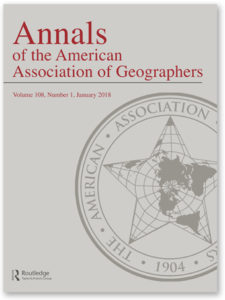Strengths and Challenges of Diversity
 It is fair to say that the recent election has created deep concerns in our community regarding issues of diversity and gender equity. This unease certainly extends far beyond the campuses. In writing about the uncertainty in America’s corporate workplaces a recent article in Bloomberg stated, “Diversity issues have come to the fore as the presidential campaign exposed and deepened bitter divisions on matters such as the treatment of women and minorities.” So, as we enter the potentially troubled waters of 2017, allow me to share some of my thoughts on the fundamental issue of diversity as it relates to our discipline and the AAG.
It is fair to say that the recent election has created deep concerns in our community regarding issues of diversity and gender equity. This unease certainly extends far beyond the campuses. In writing about the uncertainty in America’s corporate workplaces a recent article in Bloomberg stated, “Diversity issues have come to the fore as the presidential campaign exposed and deepened bitter divisions on matters such as the treatment of women and minorities.” So, as we enter the potentially troubled waters of 2017, allow me to share some of my thoughts on the fundamental issue of diversity as it relates to our discipline and the AAG.
This past month the University of California reported on our 2017 applicant pool and it makes for enlightening reading in this regard. By the numbers — the UC applicants were 34 percent Chicano/Latino, 30 percent Asian American, 25 percent White, 6 percent African American and about 1 percent American Indian and Pacific Islander. In terms of socioeconomic diversity, 42.4 percent were from low income families and 46 percent would be the first in their families to obtain a degree. On my own campus about 21 percent of the current undergraduate population are Chicano/Latino, 32 percent Asian American, 26 percent white, 5 percent African American and 1 percent American Indian/Pacific Islander. Slightly over 50 percent of UC undergraduate students are women.
This increasing diversity and gender balance amongst university students is of course not just a feature of the University of California. It is part of a long-term national trend. According to the National Center for Education Statistics (NCES) the proportion of Hispanic and Asian/Pacific Islander students in higher education tripled and African American enrollment increased by about 40 percent between 1976 and 2008. Since about 1980 women have been the majority gender amongst undergraduates. The diversity amongst graduate students remains lower than amongst undergraduates, but the NCES data indicate progress towards developing a graduate student body, which more closely resembles the complexion of the nation. The percent of African American graduate students has increased from 6 percent to 12 percent, Hispanics increased from 2 percent to 6 percent and Asians/Pacific Islanders increased from 2 percent to 7 percent. Women now account for a bit more than half of all graduate students. Recent data by NCES also shed some light on the diversity of the faculty. Although the ranks of full professor are largely dominated by White males, there is increasing ethnic and gender diversity in the more junior ranks. One would suspect that this increased diversity in the ranks of associate and assistant professors will propagate upwards into the professorial ranks over time.
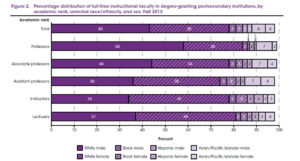
There are obvious reasons why, in a healthy and equitable democracy, access to higher education must be open to all regardless of gender, sexual orientation, ethnicity, religion or socioeconomic status. There are also many reasons why diversity bestows benefits to students in the classroom and on the campus in general. The potential added value of greater diversity has been articulated many places including in U.S. News and World Report – 1. Diversity expands worldliness in regards to exposure to people beyond a single social set, 2. Diversity enhances social development, 3. Diversity prepares students for future career success in today’s diverse workplaces, 4. Diversity provides preparation for work in a global society, 5. Diversity drives increases in the student’s own knowledge base, 6. Diversity promotes creative thinking, 7. Diversity enhances self-awareness, 8. Diversity enriches the multiple perspectives developed by higher education. It is not surprising the U.S. News and World Report includes a Diversity Index in its campus rankings.
The value of diversity extends beyond the campus setting and into professional life. For example, a study authored by Vivian Hunt, Dennis Layton, and Sara Prince and released in 2015 by McKinsey and Company examined management data for 366 public companies across a range of industries in the Unites States, Canada, the United Kingdom and Latin America. They found that firms in the top quartile for racial and ethnic diversity were 35 percent more likely to have financial returns above their national industry medians. They also found that companies in the top quartile for gender diversity were 15 percent more likely to have financial returns above their national industry medians. Interestingly, for the United States there was a linear relationship between racial and ethnic diversity and better financial performance. Every 10 percent increase in racial and ethnic diversity in senior management was correlated with an increase in earnings before interest and taxes of 0.8 percent.
Collaborator diversity has also been shown to be a positive driver of research performance. As Jean Vanski, Director of Management and Analysis, Division of Institution and Award Support at the National Science Foundation, has stated “Diversity is important to our mission because different perspectives bring to an enterprise different ways of solving problems.” Katherine Phillips argues in Scientific American that it is not just the diversity of views that is important, but the diversity of the voices expressing those views is also impactful. Differences in race and gender can actually increase the impact of novel or dissonant opinions in group research. There is also a potential payoff to diversity in the communication and impact of the resulting research. In a 2014 commentary published in Nature, Richard B. Freeman and Wei Huang of Harvard discuss an analysis of 2.5 million research papers in which they found greater ethnic homogeneity among authors was associated with publication in lower-impact journals. In contrast, papers by multi-ethnic teams of four or five authors experienced a 5-10 percent advantage in terms of citation numbers.
So, with all this in mind, we might ask how our discipline and our association are faring in terms of diversity? As it happens, there is a wonderful AAG Disciplinary Data Dashboard that allows members to explore this question in detail. If you have not visited the Dashboard I highly recommend you take a look. The data therein suggest a positive trajectory, but as of yet incomplete journey. Let’s assume that with almost 12,000 members, the association roughly represents the demography of the discipline as a whole in terms of gender balance and ethnic diversity. Since 1972 the proportion of female members has increased from less than 20 percent to about 40 percent. Close, but not quite parity when measured against the general population or university student proportions. In terms of ethnic diversity we clearly have work to do. Our numbers of African American, Hispanic, Native American/Alaskan and Pacific Islander remain markedly below the proportions of those groups in the general population.
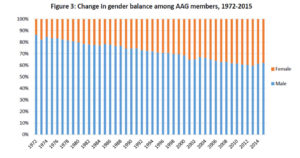
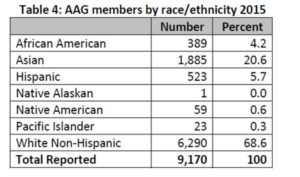
Some of this may reflect the fact that about a third of our membership is international, but I do not think that wholly explains the disparity between the AAG and the U.S. population. We should also be cognizant that our survey numbers remain incomplete in terms of socioeconomic background, sexual orientation and other attributes that contribute to the full palette of diversity in any society.
As a discipline, and as an association, we are making progress, but work remains. That work must center on making sure that the discipline of geography and the AAG are seen as relevant and valuable to a wider cross-section of the population. Here I believe there are important positive feedbacks to be realized. As we add more geographers from currently under-represented groups we add to the perspectives that geography provides and the voices by which those perspectives are communicated. Our work expands in its relevance and the message of that growing relevance is shared more widely and effectively through having a diverse membership.
We would be remiss if we think of diversity simply in terms of numbers needed to fill-out comparative spread sheets. There has been much work done in business on the challenges of the effective development and capitalization of diversity. This is often referred to as “diversity management.” As Glenn Llopis points out in Forbes Magazine, “Diversity can no longer just be about making the numbers, but rather how an organization treats its people authentically.” To be effectively and authentically diverse an organization must allow its diverse membership to be both meaningfully engaged with the organization and empowered to change operating models and chart new courses. Engagement means more than just giving voice. It means identifying priorities and providing opportunities that are relevant to broader populations. Empowerment to change priorities and operations may mean surrendering of some power by established leaders. However, as Kathy Hannan, National Managing Partner, Diversity & Corporate Responsibility, KPMG LLP, argued in the Forbes piece, “Diversity must move from just a value, to being operational.” I believe that this is the same for our discipline and association.
This all sounds good, but how can it be effected? As diversity has increased in universities and other organizations there can develop a sense of alienation by both the previously dominant or empowered groups and newly arrived and developing groups. Communication and cooperation give way to dismissal and adversity. An article in the Harvard Business Review by Tessa L. Dover, Brenda Major and Cheryl R. Kaiser suggests that in many cases corporate diversity training does little to improve such cultures or alleviate increasing senses of alienation. To overcome these challenges takes more than exposure to training, it takes more than curriculum, it takes doing by each and every one of us. Simon Goring at the Department of Geography, University of Wisconsin-Madison, was part of a team that produced an article in Frontiers in Ecology and the Environment on creating and maintaining diverse and high-performing collaborative research teams. I find the piece quite instructive on how we, as individuals, can promote a healthy diverse organization. The article highlights the importance of Social Sensitivity (empathy, honesty, clarity, integrity, accountability) coupled with Emotional Engagement (shared excitement about goals, personal commitment to the team, trust). Another important element they identify is Team Communication (evenness of talking and listening, lack of dominance, equality of interactions and tone). These values are important for any team or organization, and critical for those which are highly diverse and incorporate members with a variety of markedly different life experiences and perspectives. One might distill this all down to actively showing mutual respect.
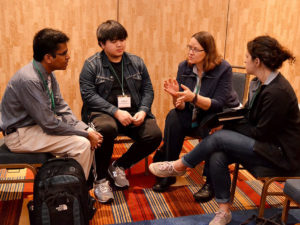 Many of our members have long been working hard in their teaching, research and service to advance the cause of diversity and equity. So too has the Association. The commitment of AAG leadership and staff from past presidents on down has been continuous. I invite you to the read the 2006 Diversity Task Force Report on goals for enhancing diversity. My recent predecessor, Mona Domosh, has written in this column about the importance of diversifying our curriculum. Each year the AAG expressly honors a geographer for their efforts toward encouraging a more diverse discipline. Geography is innately a discipline about diversity and geographers should be better equipped than most to embrace and foster a culture of diversity. If we wish to see our discipline and organization grow and prosper in an increasingly diverse nation we must do so. In addition, we as geographers can and should provide an example of the strength of diversity and the route to overcoming any challenges along that path. Let’s all think about working to achieve this, particularly in our own personal interactions, as we move forward into the New Year.
Many of our members have long been working hard in their teaching, research and service to advance the cause of diversity and equity. So too has the Association. The commitment of AAG leadership and staff from past presidents on down has been continuous. I invite you to the read the 2006 Diversity Task Force Report on goals for enhancing diversity. My recent predecessor, Mona Domosh, has written in this column about the importance of diversifying our curriculum. Each year the AAG expressly honors a geographer for their efforts toward encouraging a more diverse discipline. Geography is innately a discipline about diversity and geographers should be better equipped than most to embrace and foster a culture of diversity. If we wish to see our discipline and organization grow and prosper in an increasingly diverse nation we must do so. In addition, we as geographers can and should provide an example of the strength of diversity and the route to overcoming any challenges along that path. Let’s all think about working to achieve this, particularly in our own personal interactions, as we move forward into the New Year.
Join the conversation on Twitter #PresidentAAG
—Glen M. MacDonald


